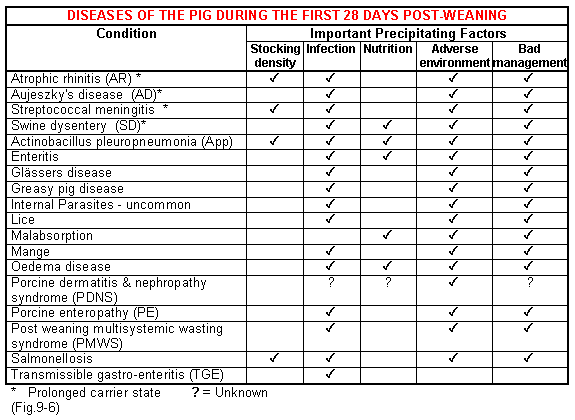



Maximum productivity
The production of healthy weaners is a complex interaction between disease, the environment and management. Management decisions and procedures however are the initiating factors that cause abnormal conditions in the immediate post-weaning phase. These factors include:
- The production and maintenance of a healthy sucking pig.
- An adequate weaning weight for the weaning system.
- An optimum age of pig for the weaning system.
- An environment with the necessary temperature, ventilation and humidity for the age and weight of the pig.
- A correct diet for the age of the pig.
- Good feeding procedures.
- An all-in all-out system.
Key points to producing a healthy sucking pig
- Use a hybrid or cross bred female.
- Satisfy the nutritional requirements of the sow both in pregnancy and lactation.
- Bring a healthy sow into the farrowing house.
- Achieve good birth weights.
- Ensure each pig receives maximum colostrum at birth.
- Use a high energy and lysine diet in lactation to provide maximum nutrition for the litter.
- Provide good farrowing house management and hygiene. (Chapter 8).
- Vaccinate the gilt and sow against E. coli diarrhoea.
- Maintain an even creep temperature.
- Provide fresh uncontaminated creep feed pre-weaning.
Age and weight of the pig at weaning
Successful weaning requires a combination of both minimum age and weight at the time of weaning to suit the weaning system. Weaning ages generally range from 14 to 28 days with most intensive farms having a mean between 21 and 26. As weaning age is reduced it is important to appreciate the potential effects this might have, not only on the pig but also on the sow.
The effects of reducing weaning age
- The younger the pig the poorer its appetite at weaning.
- Poor feed intake results in lower daily liveweight gain.
- The younger the pig is weaned the less efficiently it will adapt to and digest solid food.
- Highly specialised diets are required.
- More weaning accommodation is required.
- A more exacting weaning environment is required; more supplementary heat, more labour, more costly housing and higher creep costs.
- The piglet is more susceptible to enteric diseases.
- There is often an increase in post-weaning mortality.
- A shorter lactation may reduce subsequent litter sizes and conception rates.
- The days from weaning to first mating interval may be increased with more sows showing vulval discharges and found not pregnant.
- Pigs produced per sow per annum or pigs weaned per crate can be increased.
- Pigs may be healthier if weaned away from the farm (SEW).
- The question is "How do you determine the best age at which to wean on your farm"?
- This is dependent on:
- The number of farrowing crates.
- The milking capabilities of the sows, the breed and reproductive efficiency.
- Litter size.
- A good weight for age at weaning.
- The health of the piglets at weaning time.
- The quality and digestibility of the creep feed.
- Weaning accommodation that will satisfy the pig's requirements.
- A weaning age that results two weeks later in a healthy weaner which has achieved maximum daily liveweight gain. (Fig.9-1).
- A weaning age that does not depress efficient reproductive performance in the sow.
- The use of segregated early weaning techniques to improve health status.
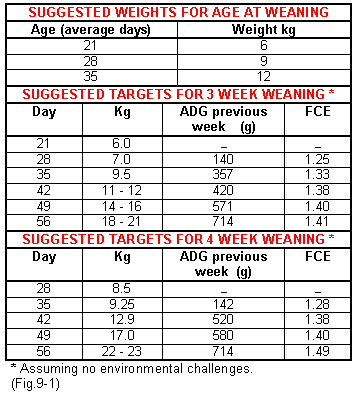
Feed intake after weaning
Optimum levels of feed intake post-weaning maximise daily gain and feed conversion efficiency and reduce costs per kilogram of liveweight gain and energy requirements.
The heavier the pig at weaning the more efficient is the growth and feed conversion during the next four weeks and the quicker it reaches slaughter weight.
Changes in the intestine of the pig at weaning
Fig.9-2 shows the cross section of the small intestine of the weaned piglet to consist of many thousands of finger like projections called villi, which increase the absorptive capacity of the small intestine. During suckling they are continuously bathed by sows milk which contains the immunoglobulin IgA. This becomes absorbed into the mucous covering the villi surfaces and prevents E. coli and other organisms attaching to the fingers. If they are unable to attach they are unable to cause disease. The secretory IgA also helps to destroy bacteria. After weaning time however no more IgA is available, the levels rapidly decline and bacteria damage the villi causing them to shrink. This atrophy reduces the absorptive capacity of the gut and the ability of the pig to use its food. The enzymes produced by the cells of the villi are likewise reduced. The changes result in malabsorption of food and poor digestion with or without the development of scour. The villi normally regenerate within 5 to 7 days after weaning from cells at their base called enterocytes, which multiply and migrate upwards causing the villi to return to their normal length. The rate of multiplication and regeneration is in part an environmental temperature and energy dependent phenomena. If the pig is weaned in an environment below its lower critical temperature (LCT), the rate of regeneration of the villi is reduced and in some cases ceases. (This results in the hairy pig that doesn't grow). Feed intake is a crucial part of the equation.
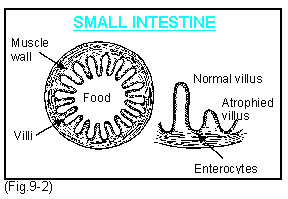
Before weaning the piglet receives milk as a liquid feed at regular intervals. As a result the bacterial flora of the gut, although relatively simple compared with that of a mature pig, is stabilised.
At weaning cessation of milk removes secretory IgA and there is a period of starvation, followed by irregular attempts to eat solid feed. This results in a dynamic disruption of the bacterial flora of the gut which may last for 7 to 10 days before stabilising. This bacterial disruption may also contribute to poor digestion and possibly scour, particularly when high levels of pathogenic strains of E. coli are involved.
Before weaning the piglets led an ordered life, being "called" with their litter mates to suckle and obtain small amounts of milk at regular intervals, sleeping between meals in a warm creep. All this suddenly changes at weaning, the pigs finding themselves in strange surroundings with strange piglets, and only solid feed. Psychological trauma is inevitable and is likely to affect some pigs more than others, resulting in impaired digestibility and lowered resistance to disease. The more this psychological stress can be minimised the better
If poor growth is evident in the first seven days post-weaning the following options or variables need to be considered:
- Check that the weights of all pigs at weaning are to the target level.
- Check the ages of the pigs at weaning.
- Heavier but younger pigs will have a more immature digestive system.
- Group the pigs by weight or keep them in their litter groups.
- Use a highly digestible and palatable diet and mix and soak this for the first day or two with water.
- Use different diets according to body weight and age.
- Use open dishes for feeding for the first three days at least, instead of troughs.
- Feed small quantities of creep four to five times daily and remove uneaten stale feed.
- Provide easy access to fresh clean water.
- Use in-feed medication for the first ten days post-weaning.
- Check that the environmental temperature is constant and satisfies the pigs requirements particularly in the first four days post-weaning.
- Maintain a dry house without draughts.
- Reduce any form of stress.
- If pigs are housed on slatted floors provide solid comfort boards for them to lie on for the first few days.
- Remove the smallest piglets from each pen after 7 to 10 days and place them together in one pen in the same room. Their diet can then be adjusted accordingly.
Key factors that dictate the degree of villus atrophy
- Age of the pig at weaning
- Weight of the pig at weaning
- The environmental temperature and its fluctuations.
- Feed intake and availability of feed.
- Digestibility of the feed.
- Quality of the proteins.
- Levels of milk proteins.
- Levels of bacterial and viral challenge.
Nutrition
Only minimal amounts of solid food are eaten during the suckling period and very little before 10 days of age.
Key points to maximising feed intake
- Pigs at weaning time will eat a warm gruel better than a solid food.
- Gruel feeding reduces the degree of villus atrophy and dehydration.
- Pigs need to be encouraged to feed in the first 2 to 3 days post-weaning because the maternal discipline of suckling every 40 minutes is lost.
- Provide creep feed for the first 72 hours in open dishes 5 to 6 times a day. This will encourage the pigs to eat and avoid over eating. Piglets naturally "root" pellets from the floors rather than a trough. Recently washed metal troughs have unattractive smells.
- By experiment place the feeders in the most attractive part of the pen.
- A small pellet or crumb will increase intake. Pellet size should be 2mm or less.
- Examine the piglets mouths at weaning time to ensure there has been no damage to the gums during teeth removal. Pigs with sore infected gums will not eat.
- Use a highly palatable diet.
Creep feeding / options
The term "creep feed" here means the pre-starter diet offered to piglets before and just after weaning until they can be changed to a cheaper starter diet. When sows were loose-housed in farrowing pens the pre-starter had to be placed in a "creep" where the sows could not get to it. Now that sows are farrowed in crates or tethers the creep is placed outside the warm creep area in a cooler part of the pen to keep it fresh but the term "creep feed" is still used.
There are a number of options:
- No creep given pre-weaning.
- Different creeps given pre and post-weaning.
- Mixed creeps given post-weaning.
- A high dense diet used pre-weaning and a low one post-weaning.
- A low dense diet used pre-weaning and a high one post-weaning
- Restricted feed for varying periods of time.
- Choice feeding.
By trial and error determine the best methods that produce a healthy rapid growing weaner.
On most farms the best method is to offer very small quantities of fresh creep feed several times a day for the last 7 to 10 days before weaning and to continue this for one to three days after weaning while gradually changing to starter rations.
Nutritional components of a good creep diet
Whilst it is not the purpose of this book to discuss nutrition in detail nevertheless Fig.9-3 shows the effects on growth rate of a simple diet compared to a complex one. A complex diet could consist of the following:
Cooked cereals 38 %, maze oil 11%, milk products 45%, Glucose and sugars 5% plus minerals and vitamins, MJ DE/kg 16.4, Protein 21 to 23%, lysine 1.3 to 1.4%, oil 20%.
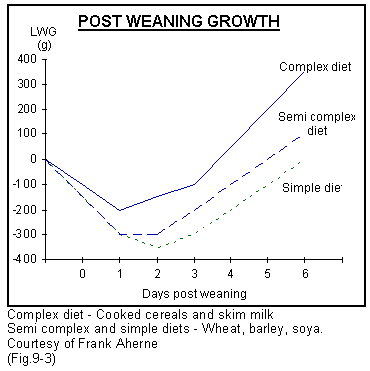
Water
At weaning time the pig's diet changes abruptly from milk as its source of nutrients to water and solid feed and it should therefore be given encouragement to drink. Water is best provided in open cube drinkers, poultry drinkers or water bowls for the first 3 to 4 days. If nipple drinkers are the only source of water many pigs may take up to 24 hours before they drink adequate amounts and if the drinkers are not functioning correctly some may never get enough.
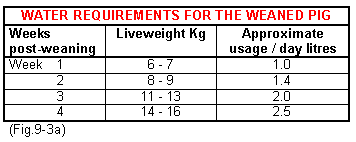
Housing
Good weaning accommodation should satisfy the following criteria;
- Be easy to clean, disinfect and be dry.
- Provide good observation.
- Require minimum handling of waste (faeces, slurry) and separate the pig from its faeces.
- Have a simple feeding system that is adaptable for the first 3 to 4 days.
- Provide a draught free, well insulated environment that satisfies the needs of the piglets.
- Segregate one weeks pigs from another, ideally at least 10m apart, with no direct air or faeces contact.
- Segregated disease control or segregated early weaning principles should be adopted. (See chapter 3).
- In flat decks and mechanically ventilated housing a fail safe and alarm system should be in operation.
- Weaner kennels, deep bedded in straw, provide an ideal post-weaning environment in temperate climates.
- If slats are used these should preferably be made of plastic and self cleaning.
Temperature requirements
Satisfying these is essential if a pig is to be weaned successfully. (Fig.9-4). These requirements are dependent upon the weight of the pig, the feed intake, the quality of the feed, the floor type and the air flow. Whilst guidelines can be given for any particular age and group of pigs these should never be relied upon totally, but rather the temperature of the building adjusted to the observed requirements of the pig. A pig in its thermo-neutral zone (its comfort zone) lies on its side making little bodily contact with its contemporaries.
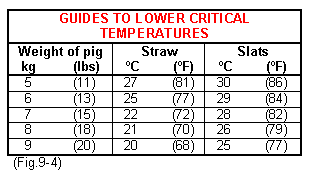
Temperature requirements of the pig are increased in wet draughty pens, or where there is high air flow. Always measure the temperature at pig level using a maximum minimum thermometer or computer monitoring equipment, placed in a guarded position.
Stocking density
The stocking density for pigs weaned on fully slatted or partly slatted floors is approximately 0.1m2 per 10kg liveweight. This should provide sufficient room for all pigs to lie down in the pen without body contact. No more than 40 pigs should be housed in each pen, ideally less (this can be doubled in deep straw accommodation) with a maximum of 200 pigs per room. Pens of pigs may be split after 10 to 14 days or the smallest pigs removed and placed together. Do not mix different ages of pigs in one room.
Problems of over stocking:
- There is a greater risk of disease developing, particularly greasy pig disease, post-weaning diarrhoea, PRRS, SI and EP.
- Growth rates are reduced.
- Vice increases including ear and tail biting.
- Ventilation problems arise.
- Ventilation
This is critical in the first 24 hours of weaning. Draughts must be avoided otherwise the pig loses energy and becomes catabolic with a predisposition to the development of disease. (Fig.9-5).
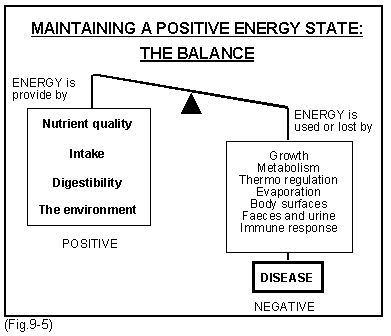
Fig.9-6 highlights the major diseases of the weaned pig and the major contributing factors. Take particular note of the importance of an adverse environment and bad management.
